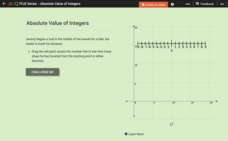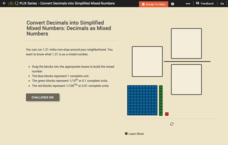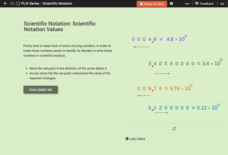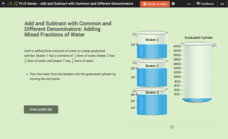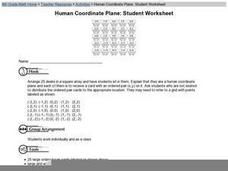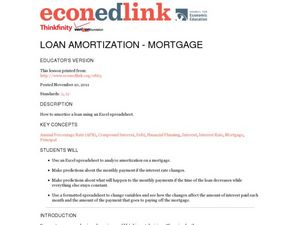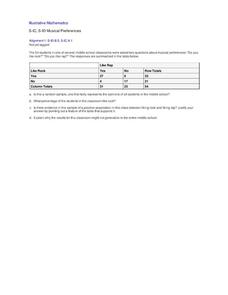CK-12 Foundation
Whole Number Multiplication: Parity of Zero
An interactive provides five questions that challenge scholars to decide whether integers are even or odd parity. A table assists problem solving with movable numbers that plug into equations and reveal the given parity. Question types...
CK-12 Foundation
Add and Subtract Decimal Numbers: Losing Little Bits
An interactive offers five questions that challenge scholars to subtract decimals. A diagram featuring a tree and birdhouse with moveable parts is designed to assist mathematicians in finding solutions. Types of questions include...
CK-12 Foundation
Absolute Values of Integers
A five-question interactive focuses on integers and absolute value. A number line shows the distance to aide mathematicians in answering multiple-choice, true or false, and discussion questions.
CK-12 Foundation
Decimals as Mixed Numbers
Five questions—multiple-choice, true or false, and a discussion—make up an interactive that focuses on decimals as mixed numbers. Moveable blocks assist scholars in finding solutions.
CK-12 Foundation
Scientific Notation Values
Scientific notation is the focus of a five-question interactive. A model with movable points offers a visual reference to help solve true or false, multiple-choice, and fill in the blank questions. A discussion question challenges...
CK-12 Foundation
Decimals as Mixed Numbers
A five-question interactive boosts scholars' knowledge of decimals and mixed numbers. Moveable base 10 blocks assist mathematicians in answering a series of multiple-choice and true or false questions. A discussion concludes the practice.
CK-12 Foundation
Fractions as Percents: Baking Cookies
A five-question interactive challenges mathematicians to solve word problems involving fractions as percents. Baking two different types of cookies and needing the exact amount requires scholars to make fractions, turn them into...
CK-12 Foundation
Expression Evaluation with Different Denominators: Adding Mixed Fractions of Water
An interactive challenges mathematicians to add mixed fractions with unlike denominators. Five questions—fill-in-the-blank and multiple-choice—build from one to the next leading the way to an open discussion about denominators and...
CK-12 Foundation
Values Written as Powers: Binary Numbers 1 to 8
A six-question interactive tasks scholars with adding binary numbers one through eight. A tool acts as a visual aid to showcase the patterns made when working with base—2, digits zero and one. Question types include fill in the blank,...
CK-12 Foundation
Values Written as Powers: Binary Numbers 9 to 16
Challenge mathematicians to crack the binary code with an interactive that focuses on numbers nine to 16. A table reveals exponential equations to aid in answering multiple-choice questions. A discussion question gauges comprehension.
Curated OER
Human Coordinate Plane: Student Worksheet
An excellent way to teach the basics of coordinate graphing is here for you! Young mathematicians take on the identity of one of the two numbers in a coordinate pair, and the entire class must arrange themselves in the proper order. This...
Curated OER
Lesson Design Protocol: Add and Subtract
Addition and subtraction are studied in this math instructional activity. Upper graders add and subtract whole numbers up to 1,000 with and without regrouping.
Curated OER
Problems Using Time
What time was it 20 minutes ago? Once your time-tellers have the basic skill down, take it up a notch with these word problems. Each one references a clock face, and scholars answer four questions for each of the three clocks (two analog...
EngageNY
Properties of Area
What properties does area possess? Solidify the area properties that pupils learned in previous years. Groups investigate the five properties using four problems, which then provide the basis for a class discussion.
EngageNY
Proving Trigonometric Identities
Young mathematicians first learn the basics of proving trigonometric identities. They then practice this skill on several examples.
Shodor Education Foundation
Triangle Area
While the lesson focuses on right triangles, this activity offers a great way to practice the area of all triangles through an interactive webpage. The activity begins with the class taking a square paper and cutting in in half; can they...
Utah Education Network (UEN)
Subtracting Integers
Review the concepts of additive inverses and adding positive and negative integers. Relate understanding to the subtraction of integers. This is done with either the use of "Algeblocks" (any square or tile manipulative should do) or a...
Curated OER
Addition and Subtraction Facts to 20
Fact families, and the relationship between addition and subtraction are the foucs of this lesson. Learners explore strategies to help with their addition and subtraction facts. They use doubles, related facts, and fact families to help...
Curated OER
Loan Amortization - Mortgage
Upper graders explore the connection between interest and principal. They use an amortization schedule to determine the amount of principal paid vs interest on a $100,000 home loan. Fourteen discussion questions and a research-based...
Curated OER
Dividing
Cement division facts with these drills which include finding remainders and long division. Learners begin by solving 15 horizontally aligned division equations, most of which have remainders. The dividends for this section are all...
Curated OER
Bar Graphs and Pictographs
How are bar graphs and pictographs different? As you begin this concept, use these simple graphs to help get learners started with data analysis styles. There is one bar graph and one pictograph, each accompanied by four or five...
Illustrative Mathematics
Musical Preferences
If you like rap music, are you more likely to like rock music? Use statistical analysis to determine if there is a positive association between rap and rock in this particular sample. While the problem is relatively simple, the...
02 x 02 Worksheets
Measuring Length
Your young forensic scientists add to and strengthen their measurement and conversion skills with these seven well-scaffold worksheets. Metric conversions, measuring length, area, and volume, reading thermometers, graduated cylinders,...
Illustrative Mathematics
How Many Cells Are in the Human Body?
Investigating the large numbers of science is the task in a simple but deep activity. Given a one-sentence problem set-up and some basic assumptions, the class sets off on an open-ended investigation that really gives some context to all...
Other popular searches
- Basic Math Skills Pretest
- Basic Math Skills Test
- Basic Math Skills Inventory
- Basic Math Skills Review
- Basic Math Skills Activities
- Math Basic Skills
- Cumulative Basic Math Skills
- Prue Test Basic Math Skills
- Pre Test Basic Math Skills
- Basic Math Skills Pretest"
- Basic Skills Math Games
- Basic Math Skills Pretest"+




